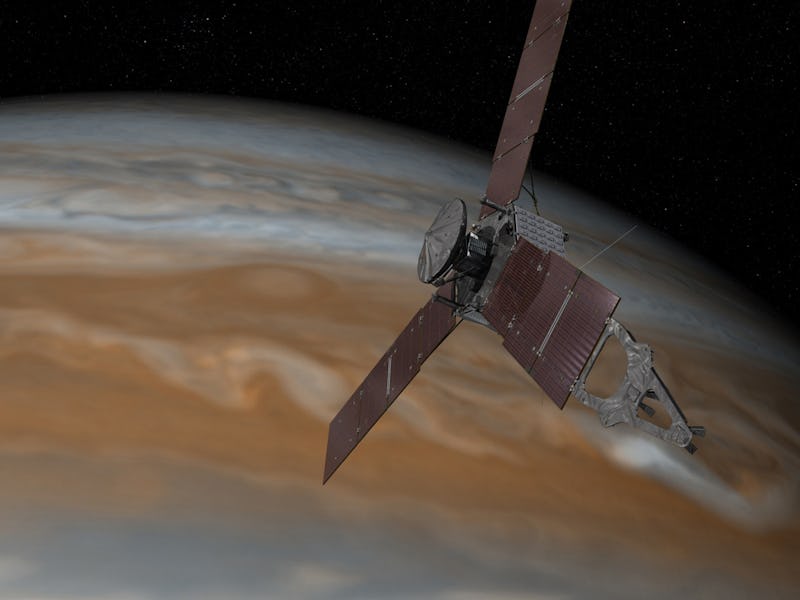NASA Unsure Why the Troubled Juno Mission Went Into Safe Mode
Still, NASA is positive about the ordeal.

Juno’s problems are getting worse and worse. NASA announced at a press conference Wednesday that its Jupiter-orbiting spacecraft entered “safe mode” at 1:47 a.m. Eastern on Tuesday — less than a week after NASA was forced to postpone a rocket engine burn that would have put Juno in a shorter orbital period around the gas giant.
The Juno team is still unsure what exactly caused Juno to enter “safe mode,” a term for when all non-essential processes stop. The mission’s principal investigator, Scott Bolton, explained that Juno operates much like a smart person does: it’s designed to detect unanticipated conditions, evaluate the situation, and automatically take whatever action it deems is necessary.
In this instance, Juno decided to turn off all unnecessary subsystems — which means all of the spacecraft’s scientific instruments were turned off — and point its solar panels toward the sun to go into a “power positive” state. As the spacecraft’s orbit brings its closest proximity to Jupiter (a mere 3,000 miles away from the cloud tops, Bolton said), it is unable to collect any scientific data, creating a missed opportunity for the close flyby.
Still, NASA is positive about the ordeal. Juno did “exactly what it was supposed to do,” said Bolton. The spacecraft now awaits new instructions from NASA before it can exit safe mode.
“It’s too early to take a guess as to what caused it,” Bolton told reporters. “It did happen pretty far away from Jupiter,” so his instinct is that this was not a problem caused by the planet’s radiation belts — which are most problematic closer to the planet’s surface. Still, there is a lot of stuff swirling around the planet, even at a far away distance, so there’s a myriad of factors that could have forced a safe mode entrance.
Assessing what caused the safe mode is not the only next step NASA needs to take. The agency also needs to determine what was causing the malfunction behind the spacecraft’s rocket engine burn. The valves that are part of the spacecraft’s fuel pressurization system experienced severe delays in opening up: “perhaps they were sticky,” Bolton said. So NASA decided to postpone the burn until it could determine the problem, how to solve it, or whether the spacecraft would be okay with going forward with the burn.
It’s a critical maneuver in the mission’s plans: the rocket burn would slow Juno’s orbital period around Jupiter down from 53.5 days to just 14 days. It’s important to note this wouldn’t bring the spacecraft closer to Jupiter — it’s close proximity flyby would remain at relatively the same distance — but it does mean those flybys would occur much more frequently.
The sunlit part of Jupiter and its swirling atmosphere, created by a citizen scientist (Alex Mai), using data from Juno’s JunoCam instrument.
NASA has rescheduled the rocket burn for December 11, the next close flyby. If the Juno team does not feel confident enough to fire up the engine at that point, it will have to postpone it for yet another day.
That will stunt the collection of scientific data, since it means Juno will be expected to run for about 20 close flybys instead of the initially planned 33. Nevertheless, Bolton emphasized that the mission was designed to allow for “very flexible science,” and the crew could very well decide to go through with the engine burn way later if it wanted. Even at a 53.5-day orbital period, radiation exposure would remain the same way it’s always been (the radiation belts are only an issue upon close approach), and increased orbital duration would not affect the spacecraft at all.
“You can accomplish an incredible amount of science in 20 orbits,” Bolton said. When asked what the worst-case scenario would be, he responded: “I have to be patient, and get the science slowly.” That’s a small price to pay for retaining a working spacecraft that’s already traveled 1.8 billion miles.
This composite image depicts Jupiter's cloud formations as seen through the eyes of Juno's Microwave Radiometer (MWR) instrument as compared to the top layer, a Cassini Imaging Science Subsystem image of the planet.
Of course, all that has to occur before 2019 — when Jupiter’s orbit around the sun reaches a point where Juno’s orbit would suddenly become eclipsed. The spacecraft is solar powered, and if it falls behind the shadow of the gas giant, there’s no guarantee it would retain enough energy to last very long — much less have enough light to take images.
But for now, there’s some incredible science happening. Juno is gathering information on the planet’s atmospheric layers, which turn out to be much more dynamic than previously thought. “Deep down…Jupiter is very different from what we see on the surface,” said Bolton. He and his team are confident they will be able to get Juno back on track and doing some more epic science in no time.